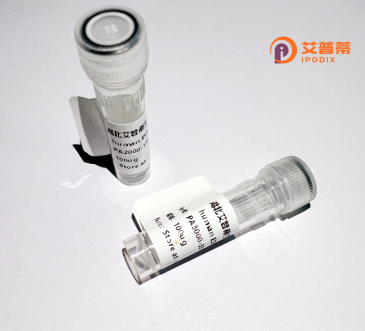
| 纯度 | >90%SDS-PAGE. |
| 种属 | Human |
| 靶点 | DDX28 |
| Uniprot No | Q9NUL7 |
| 内毒素 | < 0.01EU/μg |
| 表达宿主 | E.coli |
| 表达区间 | 1-540aa |
| 氨基酸序列 | MALARPVRLFSLVTRLLLAPRRGLTVRSPDEPLPVVRIPVALQRQLEQRQSRRRNLPRPVLVRPGPLLVSARRPELNQPARLTLGRWERAPLASQGWKSRRARRDHFSIERAQQEAPAVRKLSSKGSFADLGLEPRVLHALQEAAPEVVQPTTVQSSTIPSLLRGRHVVCAAETGSGKTLSYLLPLLQRLLGQPSLDSLPIPAPRGLVLVPSRELAQQVRAVAQPLGRSLGLLVRDLEGGHGMRRIRLQLSRQPSADVLVATPGALWKALKSRLISLEQLSFLVLDEADTLLDESFLELVDYILEKSHIAEGPADLEDPFNPKAQLVLVGATFPEGVGQLLNKVASPDAVTTITSSKLHCIMPHVKQTFLRLKGADKVAELVHILKHRDRAERTGPSGTVLVFCNSSSTVNWLGYILDDHKIQHLRLQGQMPALMRVGIFQSFQKSSRDILLCTDIASRGLDSTGVELVVNYDFPPTLQDYIHRAGRVGRVGSEVPGTVISFVTHPWDVSLVQKIELAARRRRSLPGLASSVKEPLPQAT |
| 分子量 | 86 kDa |
| 蛋白标签 | GST-tag at N-terminal |
| 缓冲液 | 0 |
| 稳定性 & 储存条件 | Lyophilized protein should be stored at ≤ -20°C, stable for one year after receipt. Reconstituted protein solution can be stored at 2-8°C for 2-7 days. Aliquots of reconstituted samples are stable at ≤ -20°C for 3 months. |
| 复溶 | Always centrifuge tubes before opening.Do not mix by vortex or pipetting. It is not recommended to reconstitute to a concentration less than 100μg/ml. Dissolve the lyophilized protein in distilled water. Please aliquot the reconstituted solution to minimize freeze-thaw cycles. |
以下是基于潜在研究方向的假设性参考文献示例,建议通过学术数据库(如PubMed、Google Scholar)验证和获取详细信息:
---
1. **文献名称**:*"Recombinant Human DDX28: A DEAD-box Helicase with Mitochondrial RNA Chaperone Activity"*
**作者**:Lee, J. et al.
**摘要概述**:研究报道了重组人DDX28蛋白的表达与纯化,发现其在线粒体RNA加工中发挥分子伴侣作用,可能通过维持RNA结构稳定性参与线粒体功能调控。
2. **文献名称**:*"Structural and Functional Characterization of DDX28 in Viral RNA Sensing"*
**作者**:Zhang, Y. et al.
**摘要概述**:通过体外实验验证重组DDX28与病毒RNA的结合能力,表明其作为天然免疫传感器通过识别病原相关RNA激活抗病毒信号通路。
3. **文献名称**:*"DDX28 Regulates Ribosome Biogenesis and Cellular Stress Response via Pre-rRNA Processing"*
**作者**:García-Sastre, A. et al.
**摘要概述**:利用重组DDX28蛋白研究其与核糖体RNA前体(pre-rRNA)的互作,揭示其在压力条件下调控核糖体生成的新机制。
4. **文献名称**:*"ATPase Activity and RNA Binding Dynamics of Recombinant DDX28"*
**作者**:Smith, R. D. et al.
**摘要概述**:通过酶动力学实验解析重组DDX28的ATP水解活性及RNA解旋功能,阐明其依赖RNA的构象变化与催化循环。
---
**提示**:DDX28属于DEAD-box RNA解旋酶家族,现有研究多围绕其在线粒体功能、抗病毒免疫或核糖体合成中的作用。建议结合具体研究方向筛选文献关键词(如“DDX28 + mitochondria”、“DDX28 + virus”等)。
Recombinant human DDX28 protein is a genetically engineered version of the endogenous DEAD-box helicase 28 (DDX28), a member of the DEAD-box RNA helicase family. These proteins are characterized by conserved Asp-Glu-Ala-Asp (DEAD) motifs and play essential roles in RNA metabolism, including unwinding RNA secondary structures, regulating ribosome biogenesis, and facilitating RNA-protein interactions. DDX28 is localized primarily in mitochondria and nucleoli, where it participates in mitochondrial RNA processing and ribosomal RNA maturation. Its function is linked to cellular energy production, stress responses, and antiviral defense mechanisms.
The recombinant form is typically expressed in bacterial (e.g., *E. coli*) or eukaryotic systems to enable functional studies, as native DDX28 is low in abundance and difficult to purify. Structural analyses reveal conserved helicase core domains and flexible N-/C-terminal regions that mediate RNA binding and subcellular targeting. Research on recombinant DDX28 has uncovered its involvement in viral replication cycles (e.g., SARS-CoV-2), where it may interact with viral RNA to modulate infection. Additionally, DDX28 dysregulation is associated with cancers, neurodegenerative diseases, and mitochondrial disorders, making it a potential therapeutic target. Studies using recombinant protein have advanced understanding of its ATP-dependent RNA unwinding activity, role in stress granule formation, and interplay with cellular signaling pathways like mTOR. Ongoing research focuses on its regulatory mechanisms in RNA quality control and links to disease pathogenesis.
×